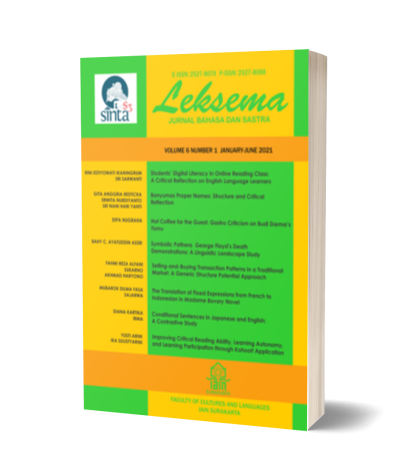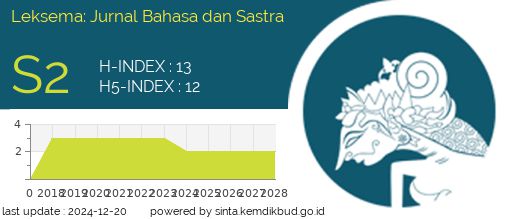THE APPLICATION OF EGP MATERIALS TO ATC STUDENTS OF CASEA MAKASSAR
DOI:
https://doi.org/10.22515/ljbs.v2i1.630Keywords:
EGP materials, ATC students, students perceptionAbstract
The objectives of this research were to find out the application of English for Generic Purposes (EGP) materials to the Air Traffic Controller (ATC) class in learning English at Civil Aviation Safety and Engineering Academy (CASEA), Makassar and the students’ perceptions toward the application the materials. This research employed descriptive qualitative research design. It applied cluster random sampling technique. The informants of this research were nineteen that consist of one lecturer and 18 ATC students of CASEA Makassar. The data were collected by observations and interviews. The observations were conducted to gather the data about the application of the materials to the students while the interviews were done to support and strengthen the data from observations whereas the interviews were also purposed for analyzing the students’ perception toward the application of the materials. The result of this research showed that (1) the application of EGP materials to ATC students of CASEA Makassar was quite effective since the lecturer had various ways in teaching English and could teach the students based on their needs as aviation students and (2) most of the students felt that both ESP (English for Specific Purposes) and EGP were so beneficial for them since as aviation cadets, they are required to be able to communicate in English. Despite the necessities for learning EGP and ESP, most of the students contended that ESP was more essential in their working environments as aircraft controllers.Downloads
References
Harati, R. Dehghan 2012. “Personal Observation of Three ESP Classesâ€. The Iranian EFL Journal. 8 (1): 318-333
Hafiz, Kasim. 2012. Identification of Common Cores in EGP and ESP, EuroJournals Publishing, Inc.
Hutchinson, T & A. Waters, 1987. English for Specific Purposes: A Learning-centered Approach. Cambridge: Cambridge University Press
Islam, M. 2011. “The Differences and Similarities between English for Specific Purposes(ESP) and English for General Purposes (EGP) Teachersâ€. Asian EFL Journal. 10 (4): 211-226
Kennedy, S & R. Bolitho. 1984. “The Role of Writing in Graduate Engineering Education: A Survey of Faculty Beliefs and Practicesâ€. English for Specific Purposes
MacKay, R & A. Mountford (eds.). 1978. English for Specific Purposes: A Case Study Approach. London: Longman
Mohseni, Mohammad. 2008. “On the Relationship Between EGP and ESP: A General Perspectiveâ€. Asian EFL Journal. 10 (4): 211-226
Nunan, David. 2004. Task-based Language Teaching. Cambridge: Cambridge University Press
Potocar, M. 2002. “ESP in Slovenian Secondary Technical and Vocational Educationâ€. English for Specific Purposes World. 1 (online): <http://www.espworld.info/Articles_1/esp.html>
Rajabi, P, GR. Kiany & P. Maftoon. 2011. “Iranian English Major vs Suject Matter ESP Teachers Beliefs and Instructional Practices in ESP Classes: A Comparative Study†in First International Conference on Foreign Language Teaching and Applied Linguistics (FLTAL) 11-2011. Sarajevo
Robinson, P. 1991. ESP Today: A Practitioner’s Guide. Hemel Hempstead: Prentice-Hall International
Sajad, D. et. al. 2014. “Observation and Feedback of Content Specialists versus General English Teachers: Suggestions to Make Optimal English for Specific Purposes Coursesâ€. Journal of English Language Teaching and Learning. 13
Strevens, P. 1988. “ESP After Twenty Years: A Re-appraisal†in M. Tickoo (ed.). ESP: State of the Art (1-13). SEAMEO Regional Language Centre
Swales, J. 1988. Episodes in ESP. Prentice Hall
Widdowson, HG. 1983. Learning Purpose and Language Use. Oxford: Oxford University Press
Downloads
Published
Issue
Section
License
The copyright of the received article shall be assigned to the publisher of the journal. The intended copyright includes the right to publish the article in various forms (including reprints). The journal maintains the publishing rights to published articles.
In line with the license, the authors and users (readers or other researchers) are allowed to share and adapt the material only for non-commercial purposes. In addition, the material must be given appropriate credit, provided with a link to the license, and indicated if changes were made. If authors remix, transform or build upon the material, authors must distribute their contributions under the same license as the original.






